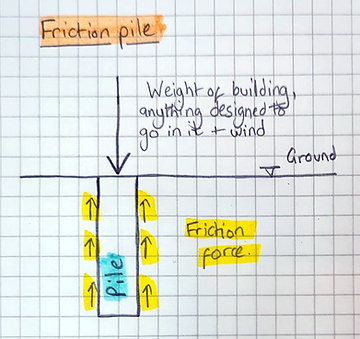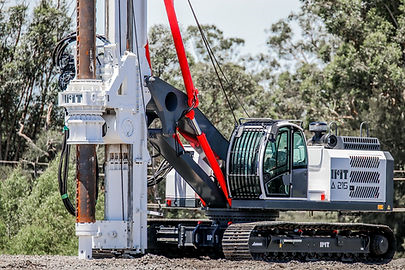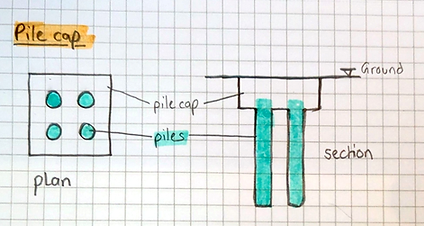Piling is the process of inserting long, slender foundations into the ground to provide support for a building.
Piling is one of the methods for providing buildings a foundation. It is often the first main site activity following site set up and enabling works which will be covered by a different post.
There are many images available online showing how force and loading diagrams for piles in different conditions but a lot of them are very complicated. The crude sketch below shows the basic principles for one type of pile.

Sketch of forces acting on a Friction pile
Definitions
Foundation – the lowermost part of a structure that distributes the weight of it and transfers it to the ground underneath.
Why do buildings need piles?
It may be easier to think of what would happen if buildings didn’t have piles or more broadly, any foundations?
If a building was constructed on say an existing car park, it would be too heavy and unstable for the ground.

Image of a piling rig – the heavy machine used to install piles into the ground
Even if the structure could take its own weight and not collapse in on itself, it would sink into the ground and if anything pushed against the side of it e.g. wind, it would simply topple over. That’s where foundations come in.
Note: not all buildings need piled foundations but all require foundations of some description.
They are often not required for smaller buildings say a 2/3 storey house which would typically use a shallower foundation. However, if the ground conditions were bad piled foundations may be considered.
Other Considerations
Piles are typically made of materials like concrete, steel, or wood dependant on the size of the building and ground conditions.
To help spread the buildings loading, they usually get grouped together into a Pile cap. A Pile cap can be visualised as a pizza saver under the ground – yes, that is the actual word for them.


Sketch of Pile Cap with 4 piles Pizza Saver
Sometimes piles can be put into larger groups and be connected to a Raft Slab. In the context of piling, a Raft Slab can be thought of as a large pile cap which covers all or most of the building footprint.
Piled foundations can be very deep – the famous Shard building in London has reinforced concrete piles up to around 54m below ground. That’s more than half the length of a Premier League football pitch.
Often the upper levels of ground is soft and easily shiftable so piles can bypass this and go down to the firmer levels below.
Definitions
Pile cap – a reinforced concrete slab constructed over a group of piles to distribute load from a structure
Reinforced concrete piles – piles constructed from concrete with steel reinforcement bars
Posts to Follow
We plan to go into more details about piling and add sections on:
- Design
- Piling Methods
- Logistics
- Temporary Works
- Build Sequence
- Health, Safety & Environment
- Quality
- Programme
- Commercial
Please let us know if you found this post useful using the chat function. We’d love to hear from you – is there anything in particular you’d like for us to focus on next?
